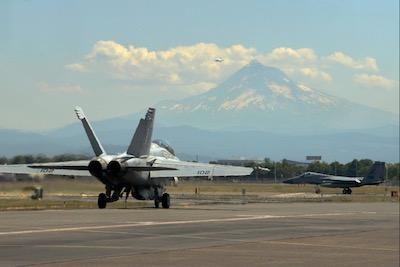F-18F Super Hornets Train With F-15C Eagles In California
The Oregon Air National Guard’s 142nd Fighter Wing hosted the VFA-41 Squadron, assigned to Naval Air Station Lemoore, California, along with their F-18F Super Hornets during two weeks of dissimilar aircraft combat training at the Portland Air National Guard Base Aug. 11-23.

As part of the DACT exercises, the Navy brought six F-18’s and approximately 125 Sailors to engage with the 142nd FW’s F-15C Eagles. The training focused on compliance and capabilities preparation, allowing both units to stay proficient while providing upgrade training to junior pilots. “We do this training about once a year when our weather is good, which supports an active flying schedule,” said Oregon Air National Guard Maj. Brent Ellis, chief of scheduling for the 142nd Fighter Wing, 123rd Fighter Squadron.
One element of the joint training helps establishes familiarization with different airframes and tactics. It also allows both sides to define the advantages and disadvantages within a dedicated training plan. “The goal of this training is to get all sides ‘together in the same room’ and fill in the capability gaps and see what our airplane (F-15C Eagle) does better than theirs, and what their airplane (F-18F Super Hornet) does better than ours,” Ellis said.
With a morning and afternoon flying schedule, this allowed both sides to role-play as the home team ‘Blue Air’ or the enemy ‘Red Air’ aggressors and rotate positions daily.
A wide variety of air-to-air encounters are calculated into the training. Ellis described some of the “6 vs. 6, 6 vs. 4 and 4 vs. 4,” scenarios factored into the daily missions. “It normally falls into an offensive counter-air situation where we will attack a base or a defensive counter-air where we will defend our base.”
Within the different mission tasks, the aircraft can engage in 2 vs. 1 or 2 vs. 4 or a variety of other combinations to achieve an objective. Ellis said that most of these tactics are, “missionized air-to-air encounters, as basic ‘blocking and tackling’ sorties.”
“It’s not very often when we can get the whole team together on the field, and then scrimmage as we have during an extended (two-week) training period,” he said.
Navy Commander Josh Appezzato, Fighter Attack Squadron 41 commanding officer, and his combat flying team of 13 pilots and 13 weapons officers welcomed the challenge to sharpen their skills against the Eagle airframe and 142nd FW pilots. “One of the biggest benefits that my pilots have seen in dogfighting with the F-15 is fighting a dissimilar airplane with a higher thrust to weight ratio than an F-18,” Appezzato said, pointing out design and capabilities features of the two supersonic airframes.
The F-18F Super Hornet is a two-seat operational jet, which allows for greater situational awareness during combat conditions and features an exclusive weapons package. The role of the second crew member on the F-18F model functions as the weapons systems officer. “The integration piece between the Navy and Air Force has been incredibly beneficial especially with some of our younger lieutenants who have never operated with the Air Force and F-15’s before,” Appezzato said, remarking how the extended training cycle help advanced air-to-air skillsets. “Almost all of our younger pilots have completed necessary upgrade training while we’ve been here.”
Having just completed a seven-month deployment in May to the Middle East and assigned to USS John C. Stennis (CVN 74), Carrier Strike Group 3, VFA-41 was responsible for deterring Russian and Syrian aircraft threats from American and coalition forces in Afghanistan, Syria and Iraq. “Unlike the training we are doing here in Oregon, on our deployment, our mission was the air-to-surface environment, supporting Marines and Soldiers on the ground as well as a Forward Air Controller (Airborne) FAC (A) mission, which allowed us to coordinate with ground forces in close contact with enemy troops,” Appezzato said.
Coming off such a recent real-world deployment, this experience brought an up-to-the-minute urgency to the training, another significant factor in the exercise tempo. “It’s beneficial that we are able to work on joint interoperability between the Navy and Air Force -- that’s how we're expected to fight and that’s how we want to train,” said Oregon Air National Guard Lt. Col. Nick Rutgers, 123rd Fighter Squadron commander.
Most of the overall training design allows for annual training requirements to be accomplished. Rutgers said that it is not so much about the hours but principally about sorties and the quality of training. “Split equally between both teams, it comes up to nearly 100 sorties in both ‘Red Air and Blue Air’ missions,” he said. “We work effectively together, refining tactics and learning from one another.”
The challenges of opposing dissimilar aircraft along with factoring in refueling operations and other variables help complete all the requirements for both units and functions as a force multiplier. “We really focused on counter-air engagements and using the tankers (KC-135 Stratotanker) to increase basic fighting maneuvers,” Rutgers said. “At the end of the day, I am very proud of how the Eagles have done against the Super Hornet.”
Overall the mutual benefit to working and training together will pay long-term dividends, preparing both rosters with the capacity to supply air superiority on a moments notice. “This is the absolute best option, where we go up against different airplanes, but training peer to peer with our sister service, who are a highly capably challenger,” Ellis said.
“This is where we can iron out all the differences and present the enemy with a coherent force.”
(Image provided with USAF news release)
 Bolen Gives Congress a Rare Thumbs-Up
Bolen Gives Congress a Rare Thumbs-Up The SportPlane Resource Guide RETURNS!!!!
The SportPlane Resource Guide RETURNS!!!! Buying Sprees Continue: Textron eAviation Takes On Amazilia Aerospace
Buying Sprees Continue: Textron eAviation Takes On Amazilia Aerospace Hawker 4000 Bizjets Gain Nav System, Data Link STC
Hawker 4000 Bizjets Gain Nav System, Data Link STC Echodyne Gets BVLOS Waiver for AiRanger Aircraft
Echodyne Gets BVLOS Waiver for AiRanger Aircraft



